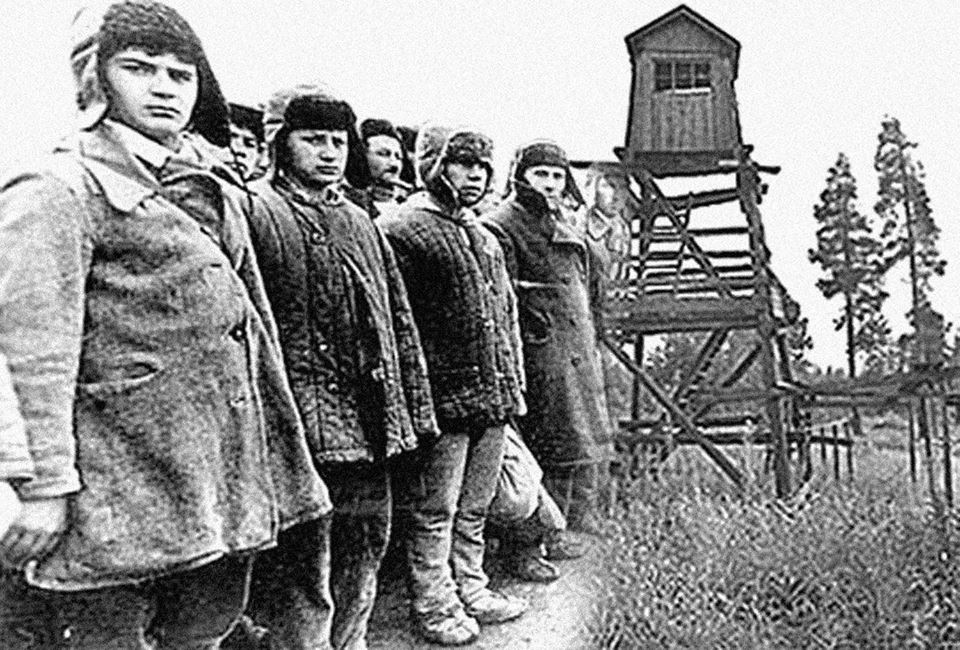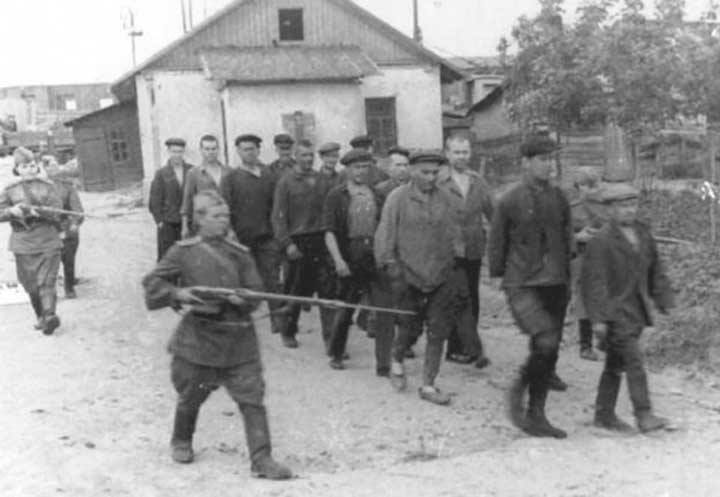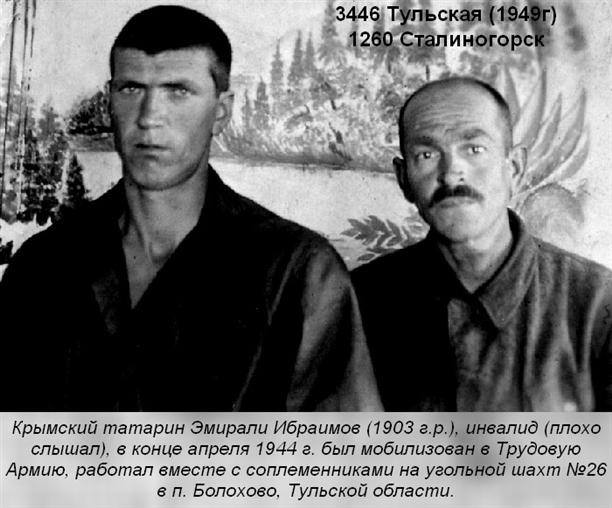Crimean Tatar Emirali Ibrahimov (1903 DOB), a person with hearing disabilities, in the end of April, 1944 was sent to the Labor Army and worked together with his compatriots on the coal mine #26 in the Bolokhovo village, Tula oblast
The files and records of the deported people are stored in the State Archives of Tula oblast. Some of them could be found in the stock #R1368 of Tula special camp #0308, where a list of the Crimean Tatars, who soon after deportation worked on the construction of the mines near the Bogoroditsy town of Tula region, was created.
As a result of the deportation of Crimean Tatars in the summer of 1944 more than 5,000 people from Crimea were sent to Moscow coal-bearing basin. The deported men were distributed to the special camps #283 and #0308 to work at the industrial plants “Moskvougol” and “Tulaugol”.
“Administration of the Control Filtration Camp (CFC) #0308 of the USSR NKVD”. Crimean Tatars – are special settlers.
All documents and materials relating to repression against the Crimean Tatars due to their deportation from Crimea in 1944, until recently, were classified as ‘top secret”.
First of all, the documents belong to the stock #P-1368 of the State Archive of Tula region entitled “Administration of the Control Filtration Camp #0308 of the USSR NKVD”. These completely new sources allow us to restore the daily life of the prisoners, their way of life, mood, and, most importantly, the attitude of the special contingent to the Stalinist regime and war.
Crimean Tatars, exclusively able-bodied men settled in the Moscow region, were sent through military enlistment offices. There were no women or children among them.
All special settlers worked in the coal industry, including coal mining, new mines construction, industrial and residential construction and other auxiliary works.
WHAT IS CFC #0308?
The camp was built in 1944, but first camp divisions appeared there at the end of 1943. According to the archive documents by February 1, 1945, due to camps’ rapid development there were ten subdivisions. The Camp Center was located in the city of Tula (18th camp unit) and camp units 12 – 72 km from the center (Administration).
The main type of work undertaken there was coal mining. People lived in barracks and dugouts of the camp units that were 150 m to 2 km away from the mines. They worked in three shifts for eight hours.
Dugouts, barracks, tents … and was it possible to live in such conditions? What this Control Filtration Camp №0308 was like?
Let’s see what the found documents say.
On November 5, 1945, captain Tokareva, Chief of the sanitary unit of the camp medical service reports to the camp commander Colonel Khodas about horrifying sanitary condition of two camp units #11 and #24:
“The camp unit #11 has two zones. The territory of both zones due to lack of solid surfacing is very dirty. Special contingent brings this dirt from the territory into their tents and dugouts, due to the serious water shortage they don’t wash themselves. For the last two months the special contingent had no bath and hair cut – almost all found dirty and with overgrown hair…
Every person randomly checked by me was massively lice-ridden…
Due to the lice infestation and dirtiness, the considerable number of special contingent is infected with skin diseases that lead to its weakening and loss of employment fund.
After the food testing on November 3, at breakfast it was found that the quality of food was very bad, namely soup cooked from raw and partially rotten potatoes that caused sour putrid smell and was extremely unpleasant to eat…
There are a lot of sick people in the camp unit (up to 40 people), it was impossible to state the exact number (as they were not in the hospital but in the barracks and were not taken into account).
Despite this number of critically ill patients and the lack of opportunity to treat them in the camp units, patients are not delivered to the central hospital of the camp”.
The same picture was in the camp unit #24. Camp doctor Tokareva noted in her report that patients were not hospitalized. Almost every one of 137 people of recreational team suffered from dystrophy and needed immediate hospitalization, otherwise they could die.
Such terrible conditions led to decrease of the number of camp residents, and made healthy people terminally ill “goners”.
Crimean Tatars were kept in the camp unit #12 (Begichevo village not far from Bogoroditsky town) as well as units #11 and #25.
“Special contingent” of the CFC #0308 worked mainly in coal production mines or on construction sites. The working day was divided into three shifts of eight hours each. The prisoners had to walk at least 2-3 km from the camp to the mine without any warm winter clothing.
Dry words of these documents allow us to reconstruct the horrific picture of the camp daily life.
The prisoners used to work seven days a week. If we consider that to some of the mines the prisoners had to walk 2-3 kilometers, and then wait for the previous shift to get to the surface, the time at work increased from eight to ten hours.
Hard work, complicated by bad weather conditions (cold, slush), made even the strongest prisoners weak.
Dystrophy among prisoners became a daily occurrence.
Tokareva, Head of the Sanitary Service of the camp, was one of the few who raised the alarm in December 1945:
“I keep getting reports from the head of the medical unit of the 11th camp unit that the Head of the camp unit Major Pyatyshev provides no transport to take sick prisoners to the Central hospital, so that patients die while in the hospital they could have been saved.
At the same time I have signals that the number of dystrophic and weakened prisoners of the 24th camp unit, and especially of the 11th camp unit is continuously growing.
Heads of the camp units ignore your instructions, and make prisoners with dystrophy work.
This situation can result in catastrophically high mortality in the coming days.
 Members of the Labor Army
Members of the Labor Army
Given that the heads of the camp units #11 and #24 do not undertake effective measures to save the physical condition of the contingent, this could ultimately lead to mass mortality (especially in the camp unit #11) …”
Bedbugs, lice, shortage of medicine – all this led to the spread of typhoid and other infectious diseases.
The prisoners of the camp didn’t have essentials necessary to survive – that is clothing, blankets, medicines, etc. People brought to the camp, could only rely on their own strength, they had to survive. Moreover, the special contingent had to work and beat the target.
The Crimean citizens worked mainly in the mines. They were brought to Tula in June 1944, but they had no miner skills, that’s why failed to fulfill a plan.
 Back to work under guard
Back to work under guard
Crimean Tatars’ unrest was growing massively, because they knew nothing about their families’ location. The camp authorities in order to avoid further unrest assured the prisoners, that they would be informed about their families as soon as this information appears.
Crimean Tatars believed that they got a raw deal:
“… There is certain dissatisfaction on the part of some people as to why they are being kept behind barbed wire and taken to work under guard; why their families were evacuated from Crimea; why they have bad clothes and shoes – they believe this is not right”.
In personal conversations (August, 1944), Crimean Tatars came to the conclusion that the Soviet government does not care about them because it separated them from their families. Many of them had little hope to see their wives and children alive after their release.
The camp authorities took some measures to calm the prisoners down. Tatars were explained that “the Soviet government takes care about the Soviet people everywhere”.
Life in the CFC forced one part of the detainees to toe the line of the camp, others to resist and fight for their rights. The most active Crimean Tatars chose the latter, preferring death from the bullet of a soldier while trying to escape to slow and painful death in the mine.
From the secret reports:
“The special settlers, able-bodied only (the Crimean contingent), by the decision of the State Defense Committee were sent to the Moscow region to work in the coal industry. Their families live: Crimean Tatars – in Uzbekskaya SSR, and other nationalities deported from the Crimean Autonomous Soviet Socialist Republic – in the Sverdlovsk region. The lists with the information about their families’ location are sent.
Special settlers (the Crimean contingent) are held in the zones, surrounded by the barbed wire and guarded by the paramilitary security service of the enterprises.
Crimean contingent was distributed to “Moskvougol” company and “Mosshahtoctroy” company in August-September 1944. During this period of time, 252 pers. escaped, 99 pers. detained, 92 of them prosecuted and 7 people are on their way to our disposal. Thus, as of January 1, 1945 153 people are on the run and put on the wanted list.
The biggest number of escapes took place in August and September. This is explained by the fact that the companies “Moskvougol” and “Mosshahtostroy” did not prepare the zone and did not provide reliable security while receiving the contingent from the special camp #283 of the USSR NKVD.
With the help of the measures taken to prevent further escapes, number of escapes decreased dramatically in the next few months. Thus, there were 17 escapes in November 1944 and 6 escapes in December, 17 of them arrested and prosecuted”.
Head of the Special settlements of NKVD in Moscow and Moscow region, Lieutenant Colonel of State Security Nikulochkin.
________________________________________
Original document “ГА РФ. Ф. Р-9479. On. 1. Д. 164. Л. 128-132”.
Ibrahim VOYENNY





